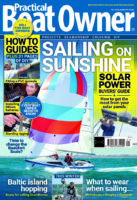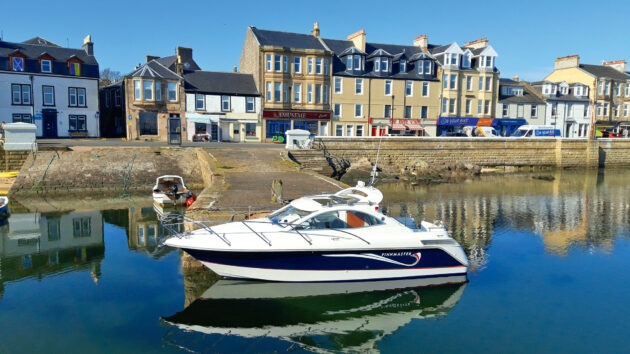Andrew Morton explains how a bow thruster remote control helped him manoeuvre safely alongside a new jetty in potentially shallow water.
Up until I found myself manoeuvring in close, shallow waters, I had gave little consideration to the advantages of having a bow thruster remote control.
Many years ago, I took my 25ft motorboat Tiptoe through the Forth and Clyde canal, before the new section was opened at the east end – the Kelpie end. In those days, the timing at Grangemouth was crucial because the water dried out under a low bridge at low tide. Yachts had to take their masts down, and we all had to choose the right moment to pass under the bridge without catching top or bottom.
The tidal range is 3-5m, which is handy. I worked it all out and phoned the lock-keeper to warn him of my arrival time, to which he replied: “You need to come a good half-hour earlier, Mr M.”
I accepted his advice without question, arrived at the allotted time… and hit the bottom with my propeller.
My calculations had been correct and his instruction wrong, which reminded me of the excellent advice I was given many years ago as an accident investigator: “Andy, always apply the ABC of life to every new situation”
A: Assume nothing
B: Believe no one
C: Confirm everything.
To which was added, “And don’t forget to X, Y, Z”. Xamine Your Zip!
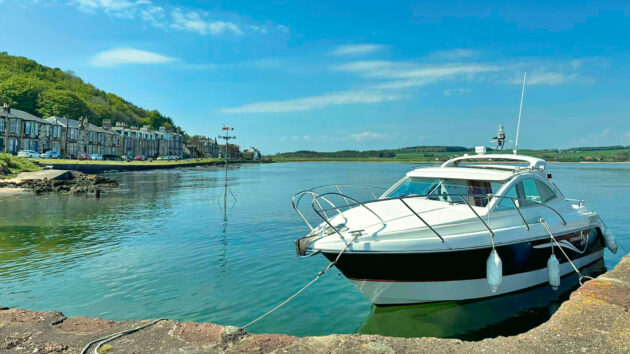
The Finnmaster 76CA Tiptoe safely moored alongside Kilchattan Jetty. Photo: Andrew Morton.
Applying the ABCs
Wind the clock forward to October 2024. I want to pick up some friends from Kilchattan Bay on the island of Bute to give them a wee trip on Tiptoe. I’ve never been before, so first I looked it up on Google, to check it out. There’s a stone jetty for sure, but it didn’t look that hopeful.
Next step, ask the ‘experts’. I’m a member of the West of Scotland Boating Facebook page. So I posed the question, to which the universal reply was a polite ‘No’. Although one wag suggested I refer to a chart!
But logically, why construct a jetty if it’s not accessible at least at high tide?
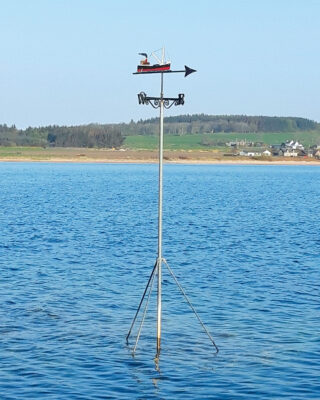
The shallow marker at Kilchattan Bay. Photo: Andrew Morton.
Testing my bow thruster remote control
I remembered the ABC of life and decided to have a look for myself, to confirm everything.
So, on 13 October, I left the house at 6am and drove to Largs Marina, where I keep my boat. From there, it’s only seven miles across the Firth of Clyde to Bute, but I needed to be back home by 1pm for family reasons, and the drive takes 90 minutes. So, a tight schedule.
High tide was at 9am, and no wind or rain, but close to 0°C. Tiptoe has a couple of heaters in the enclosed cabin, so no trouble in that department. Why would anyone want a motorboat without a proper enclosed cabin in Scotland?
And there’s another reason for this pocket adventure. I had a new gizmo to test, the Vetus WRCBS wireless remote control for the anchor winch and the bow-thruster.
Tiptoe can do 30 knots flat out, and cruises nicely between 20 and 25 knots, although to be honest, I mostly cruise at 6 knots, as it’s quieter, safer and much more economic. On arrival at Kilchattan, I moved gently towards the jetty, and with the engine in idle, walked up to the bow of the boat with the remote in my hand.
I had used the remote a few weeks earlier. It was on a lanyard around my neck. In this risk-adverse world, lanyards have a clip which gives way too easily under tension to avoid strangulation. Of course, it snapped open as I walked towards the foredeck, and the remote dropped in the water. That was £60 down the metaphorical plughole.
Now I have a float attached to my replacement, as well as a lanyard. So it’s not going to be lost in the briny today.
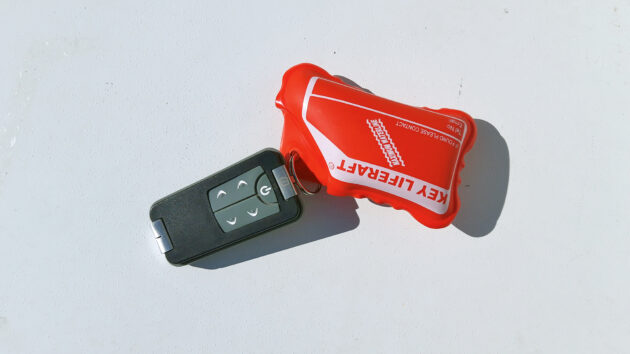
The bow-thruster remote control.
Manoeuvring with a bow thruster remote control
The wonderful thing about this remote is that I was now standing on the bow, looking down at the sandy bottom through the crystal-clear water and drifting gently towards the stone pier. With the remote, I can turn the boat left or right, or right round if I see an obstacle ahead – brilliant.
You do, of course, need clear water, and I wouldn’t be undertaking this manoeuvre unless it was windless. As expected, there were no obstacles and the depth sounder was giving me a little over 2m on the neap high tide. The sides of the stone jetty were vertical too, so there was no chance of damaging the hull.
Tiptoe draws less than a metre with the stern drive right down. So, having checked all was OK, I backed off, fixed on the fenders and warps, and then motored back in to tie up.
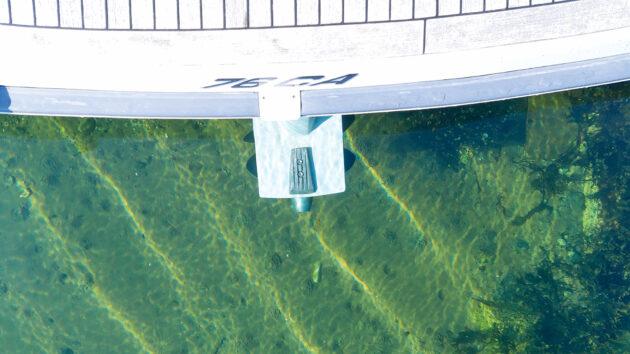
Clear water allowed Andrew to test out the remote control for his bow-thruster. Photo: Andrew Morton.
I had at least an hour to stay put, but only needed half an hour to explore the seafront, take pictures, and check the Post Office, which also doubles as a coffee shop. The jetty here is beautifully maintained, with a toilet which was open, and had clearly just been cleaned that morning.
A request for donations was accepted, and £10 popped in the box; I am more than happy to help the volunteers.
Reflections
With Tiptoe firmly in the green zone (as shown on the chartplotter) and not touching the bottom, I thought about all those people who had advised me not to try it. Well, of course, charts are based on chart datum, and if the neap tide has a range of 2m, then so long as there are no underlined numbers on the chart, it should be possible to go into a green zone at high tide in a boat with a draught of 80cm. And spring tides on the Clyde are even better, with a range of +3m.
The chartplotter showed 2m of water under the hull as I travelled across the green zone at a safe two knots. I don’t often make a habit of this shallow water cruising, but it illustrates the point quite well when the bottom is just sand.
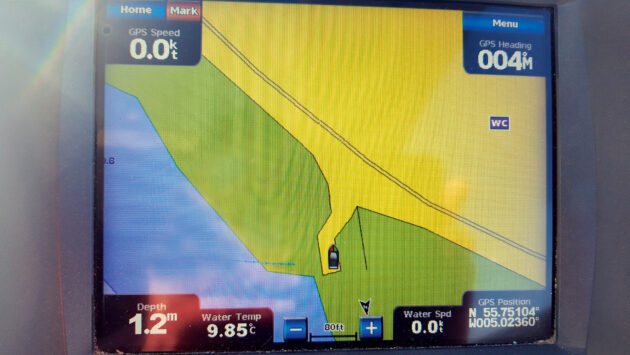
On Andrew’s chartplotter, Kilchattan Bay jetty is green’ on the chart, meaning the area dries out at low tide. But he had 1.5m under the keel at high neap tide – more than enough for his boat’s 0.8m draught. Photo: Andrew Morton.
So, in the end, there was no problem with coming alongside at Kilchattan jetty; the application of ABC proved the point. I then headed back to Largs, with a quick stop at Millport, where there’s a similar stone jetty, accessible at high tide, just perfectly placed for Tiptoe. I skipped ashore to buy a delicious, genuine Italian ice cream at the Ritz café on the way home, and my pocket adventure was complete and a success.
But one final ABC warning when checking out a new jetty: Always Be Careful.
Top tip: benefits of a bow thruster remote control
I have never liked reversing into a pontoon in my boat, because there is no keel to speak of, and the Bernoulli effect invariably causes the bow to swing out of control, especially if it’s windy. Going forward is easy because the Bernoulli effect helps keep the bow on track, quite the opposite of going backwards, not surprisingly.
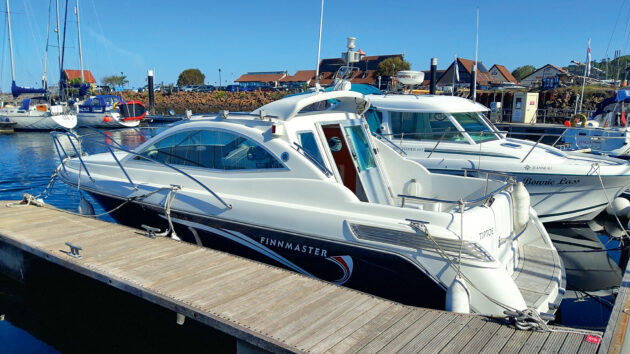
Tiptoe after Andrew reversed the boat remotely. Photo: Andrew Morton.
I bought a remote control for my new bow-thruster. The old thruster gave up the ghost after 12 years of useful, reliable service. So, a new one was fitted. The remote was just an afterthought, which has turned out to be a super addition to my armoury of boaty gadgets.
First, the caveats: my boat has a single outdrive with contra-rotating props, and it weighs just over two tons. The contra-rotating props remove prop-walk, which is very handy.
So, here’s the trick for reversing into a pontoon with a very twitchy boat.
1. Run the boat parallel to the pontoon and come past it only a metre or so away from the end.
2. Stop the boat when the stern has passed the end of the pontoon by a couple of metres.
3. Run the bow-thruster to swing the bow through 90°. Now you are ready to reverse into the slot.
4. Reverse very slowly to bring the stern close to the end of the pontoon.
5. Slip the engine into neutral, leave the helm and walk to the stern.
6. The boat should be moving slowly back past the end of the pontoon. So walk off the stern onto the pontoon. There’s no one on the boat now, but you have control of both the stern AND the bow, because of the remote operation of the bow-thruster.
7. Now the boat is moving back very gently, and you can pull the boat along the pontoon if you want.
8. As it moves back, you have total control of the bow, which makes all the difference in the world.
9. Only one problem: how do you stop the boat from moving back when there’s no one on board? Because it’s not moving quickly, you can do so by muscle power, or simply by having springs and warps ready to hook over the cleats on the boat. Finally, jump back on board and switch off the engine.
10. One other bonus: the outdrive is set straight ahead because you haven’t used it to manoeuvre the boat. So the next time you leave the pontoon, you travel straight out.
I have to say, I never thought for a moment how useful this little gadget would be. Highly recommended.
Andrew fitted the Vetus WRCBS wireless remote control system, 12/24V, including base unit, one remote control and two connection cables, around £430, www.vetus.com.
How does a boat bow thruster work?
How does a boat bow thruster work? Mike Attree explains, and shares how he repaired this handy bit of kit…
How to retrofit a bow thruster
Tony Moss and his wife, Marike, enhance the manoeuvrability of their Dufour 44 to make cruising life easier in their…
Should I get a bow thruster? Our expert answers your question
Q: I have a Vancouver 32 and I’m considering fitting a bow thruster as it’s a long keel yacht and…
Remote control bow and stern thrusters: reader tested
Will Renilson improves boat handling aboard his Jersey 36 and tests the Vetus remote control system and the Coastline Technology…
Want to read more articles like this?
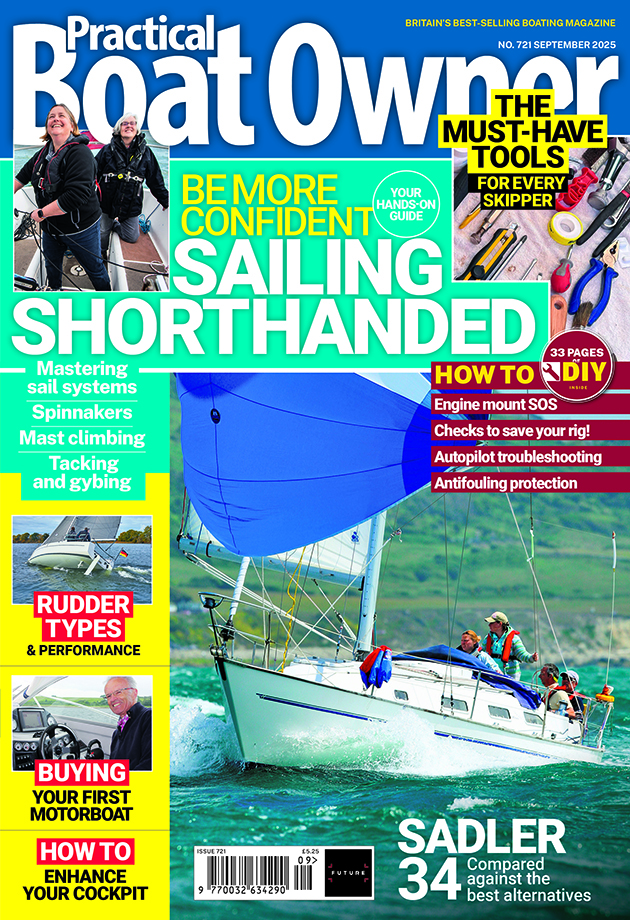
A subscription to Practical Boat Owner magazine costs around 40% less than the cover price.
Print and digital editions are available through Magazines Direct – where you can also find the latest deals.
PBO is packed with information to help you get the most from boat ownership – whether sail or power.
-
-
-
- Take your DIY skills to the next level with trusted advice on boat maintenance and repairs
- Impartial, in-depth gear reviews
- Practical cruising tips for making the most of your time afloat
-
-
Follow us on Facebook, Instagram, TikTok and Twitter

